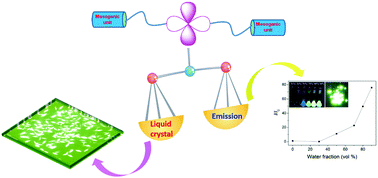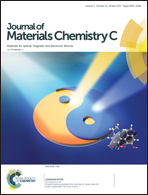Highly efficient blueish-green fluorescent OLEDs based on AIE liquid crystal molecules: from ingenious molecular design to multifunction materials†
Abstract
In order to seek the balance point between liquid crystallinity and high efficiency emission, two novel aggregation-induced emission-based (AIE) liquid crystal materials of TPE-PBN and TPE-2PBN, which contain a tetraphenylethene derivative as the emission core and a 4-cynobiphenyl moiety as the mesogenic unit, were designed and prepared. Both simple molecules showed a mesophase at high temperature as evidenced by polarised optical microscopy (POM), differential scanning calorimetry (DSC) and temperature-dependent X-ray diffraction (XRD). Simultaneously, TPE-PBN and TPE-2PBN presented clear AIE characteristics in the blueish-green region and achieved a high emission quantum efficiency of 71% and 83% in the solid state, respectively. Due to the self-assembly properties of thermotropic liquid crystals, both compounds showed higher hole mobilities in the annealed films than in pristine films. Employing TPE-PBN and TPE-2PBN as the emitting materials, both non-doped devices and doped devices were fabricated. The TPE-PBN-based doped OLEDs showed a better device performance with an external quantum efficiency (EQE) of 4.1% which is among the highest EQEs of blue AIE fluorescent OLEDs.



 Please wait while we load your content...
Please wait while we load your content...